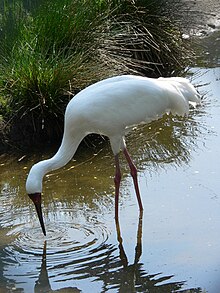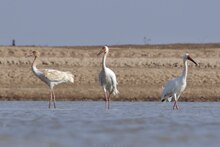Siberian crane
| Siberian crane | |
|---|---|

| |
| A captive individual in a zoo | |
| Scientific classification | |
| Domain: | Eukaryota |
| Kingdom: | Animalia |
| Phylum: | Chordata |
| Class: | Aves |
| Order: | Gruiformes |
| Family: | Gruidae |
| Genus: | Leucogeranus Bonaparte, 1855 |
| Species: | L. leucogeranus
|
| Binomial name | |
| Leucogeranus leucogeranus (Pallas, 1773)
| |

| |
| Migration routes, breeding and wintering sites | |
| Synonyms | |
| |
The Siberian crane (Leucogeranus leucogeranus), also known as the Siberian white crane or the snow crane, is a bird of the family Gruidae, the cranes. They are distinctive among the cranes: adults are nearly all snowy white, except for their black primary feathers that are visible in flight, and with two breeding populations in the Arctic tundra of western and eastern Russia. The eastern populations migrate during winter to China, while the western population winters in Iran and (formerly) in Bharatpur, India.
Among the cranes, they make the longest distance migrations. Their populations, particularly those in the western range, have declined drastically in the 20th century due to hunting along their migration routes and habitat degradation. The world population was estimated in 2010 at about 3,200 birds, mostly belonging to the eastern population with about 95% of them wintering in the Poyang Lake basin in China, a habitat that may be altered by the Three Gorges Dam.[needs update]
Taxonomy and systematics

The Siberian crane was
A
Description

Adults of both sexes have a pure white plumage except for the black
Distribution and habitat
The breeding area of the Siberian crane formerly extended between the
Behaviour and ecology
Siberian cranes are widely dispersed in their breeding areas and are highly territorial. They maintain feeding territories in winter but may form small and loose flocks, and gather closer at their winter roosts. They are very diurnal, feeding almost all throughout the day. When feeding on submerged vegetation, they often immerse their heads entirely underwater. When calling, the birds stretch their neck forward.[17] The contexts of several calls have been identified and several of these vary with sex. Individual variation is very slight and most calls have a dominant frequency of about 1.4 kHz.[24] The unison calls, duets between paired males and female however are more distinctive with marked differences across pairs.[25] The female produces a higher pitched call which is the "loo" in the duetted "doodle-loo" call. Pairs will walk around other pairs to threaten them and drive them away from their territory.[17] In captivity, one individual was recorded to have lived for nearly 62 years[26] while another lived for 83 years.[27]
Feeding
These cranes feed mainly on plants although they are
Breeding
Siberian cranes return to the Arctic tundra around the end of April and beginning of May.[31] The nest is usually on the edge of lake in boggy ground and is usually surrounded by water. Most eggs are laid in the first week of June when the tundra is snow free. The usual clutch is two eggs, which are incubated by the female after the second egg is laid. The male stands guard nearby. The eggs hatch in about 27 to 29 days. The young birds fledge in about 80 days. Usually only a single chick survives due to aggression between young birds. The population increase per year is less than 10%, the lowest recruitment rate among cranes. Their success in breeding may further be hampered by disturbance from reindeer and sometimes dogs that accompany reindeer herders.[17] Captive breeding was achieved by the International Crane Foundation at Baraboo after numerous failed attempts. Males often killed their mates and captive breeding was achieved by artificial insemination and the hatching of eggs by other crane species such as the Sandhill and using floodlights to simulate the longer daylengths of the Arctic summer.[32]

Migration
This species breeds in two disjunct regions in the arctic tundra of
Status and conservation

The conservation status of the Siberian crane is very serious. In 2008, the decreasing world population was estimated to be around 3500–4000 individuals, nearly all of them belonging to the eastern breeding population.
Historic records from India suggest a wider winter distribution in the past including records from Gujarat, near New Delhi and even as far east as Bihar.[18][34] In 1974 as many as 75 birds wintered in Bharatpur and this declined to a single pair in 1992 and the last bird was seen in 2002.[35] In the 19th century, larger numbers of birds were noted to visit India.[36] They were sought after by hunters and specimen collectors. An individual that escaped from a private menagerie was shot in the Outer Hebrides in 1891.[37] The western population may even have wintered as far west as Egypt along the Nile.[38]
Satellite telemetry was used to track the migration of a flock that wintered in Iran. They were noted to rest on the eastern end of the Volga delta.
Significance in human culture
For Siberian natives –
References
- ^ . Retrieved 11 November 2021.
- ^ "Appendices | CITES". cites.org. Retrieved 2022-01-14.
- ^ Peters, James Lee, ed. (1934). Check-list of Birds of the World. Vol. 2. Cambridge, Massachusetts: Harvard University Press. p. 153.
- ^ Pallas, Peter Simon (1773). Reise durch verschiedene Provinzen des Russischen Reichs (in German). Vol. 2. St. Petersburg: Academie der Wissenschaften. p. 714.
- ISBN 978-1-4081-2501-4.
- ^ Divyabhanusinh (1987). "Record of two unique observations of the Indian cheetah in Tuzuk-i-Jahangiri". Journal of the Bombay Natural History Society. 84 (2): 269–274.
- ^ Bowdler Sharpe, R (1893). "[Meeting notes]". Bulletin of the British Ornithologists' Club. 1 (7): 37.
- ^ Hartert, E (1922). Die Vogel der parlaarktischen Fauna. Band 3. Berlin: Verlag von R Friedlander and Sohn. pp. 1819–1820.
- ^ Bowdler Sharpe, R (1894). Catalogue of the Fulicariae and Alectorides in the collection of the British Museum. London: Taylor and Francis. pp. 261–262.
- JSTOR 4088599.
- ^ Wood, D S (1979). "Phenetic relationships within the family Gruidae" (PDF). Wilson Bulletin. 91 (3): 384–399.
- S2CID 85412892.
- ^ Gill, Frank; Donsker, David, eds. (2019). "Flufftails, finfoots, rails, trumpeters, cranes, limpkin". World Bird List Version 9.2. International Ornithologists' Union. Retrieved 26 June 2019.
- ^ Bonaparte, Charles Lucien (1855). "Tableaux synoptiques de l'ordre des Hérons". Comptes Rendus Hebdomadaires des Séances de l'Académie des Sciences (in French). 40: 718–725 [720].
- ^ a b c Rasmussen, PC & Anderton, JC (2005). The Birds of South Asia. The Ripley Guide. Volume 2. Smithsonian Institution and Lynx Edicions. p. 138.
- ^ Ali, S. & Ripley, S. D. (1980). Handbook of the Birds of India and Pakistan. Volume 2. New Delhi: Oxford University Press. pp. 144–146.
- ^ ISBN 978-0-253-11255-2.
- ^ a b Baker, E. C. S. (1929). Fauna of British India. Birds. Volume 6 (2nd ed.). London: Taylor and Francis. p. 53.
- ^ Grus leucogeranus (2011).
- ^ Grue de Sibérie. oiseaux.net
- ^ Beaman, M., & Madge, S. (2010). The handbook of bird identification: for Europe and the western Palearctic. A&C Black.
- ^ Klenova, A. V., Goncharova, M. V., Kashentseva, T. A., & Naidenko, S. V. (2020). Voice breaking and its relation to body mass and testosterone level in the Siberian Crane (Leucogeranus leucogeranus). Journal of Ornithology, 161(3), 859-871.
- ISBN 978-0-85112-235-9.
- ^ Bragina EV, Beme IR (2007). "[Sexual and individual differences in the vocal repertoire of adult Siberian Cranes (Grus leucogeranus, Gruidae)]" (PDF). Zoologičeskij žurnal (in Russian). 86 (12): 1468–1481. Archived from the original (PDF) on 2011-09-01.
- S2CID 36289511.
- ^ Davis, Malcolm (1969). "Siberian Crane longevity" (PDF). Auk. 86 (2): 347.
- ^ Temple, Stanley A. (1990). "How long do birds live The passenger pigeon" (PDF). Current Ornithology. 52 (3).
- S2CID 25193680.
- ^ Quinton W. H. St. (1921). "The White Asiatic crane". The Avicultural Magazine. 12 (3): 33–34.
- S2CID 21452196. Archived from the original(PDF) on 2011-07-22.
- S2CID 24230271.
- .
- . Retrieved 28 January 2023.
- ^ Blyth, Edward (1881). The natural history of the cranes. R. H. Porter. pp. 38–44.
- ISBN 978-1461407997. Retrieved 27 August 2019.
Siberian Crane Leucogeranus leucogeranus (Fig. 3.33) used to be the most charismatic and rare bird at Ghana or the Keoladeo National Park of Bharatpur. At one time, hundreds of "Sibes" used to winter in the Ghana Bird Sanctuary. Like white ghosts in the mist, they were lured by other north Indian wetlands from far and near. The "Sibes" used to visit Ghana from their breeding grounds in Siberia in search of food owing to the nonavailability of summer supplies due to extreme cold. No Siberian Crane was sighted in Bharatpur since 2003.
- ^ Finn, Frank (1906). How to know the Indian waders. Thacker, Spink and Co. pp. 82–83.
- ^ Clarke, WE (1892). "The reported occurrence of Grus leucogeranus Pallas, in the Outer Hebrides". The Annals of Scottish Natural History. 1 (1): 71–72.
- .
- .
- doi:10.1016/S0006-3207(01)00259-2. Archived from the original(PDF) on 2011-07-22.
External links
- International Crane Foundation's Siberian crane page
- BirdLife Species Factsheet
- Siberian Crane Flyway Coordination (SCFC) enhances communication among the large network of scientists, governmental agencies, biologists, private organizations, and citizens involved with Siberian crane conservation in Eurasia.
- Online broadcasting of white cranes’ lives from the Oksk hatchery arose

